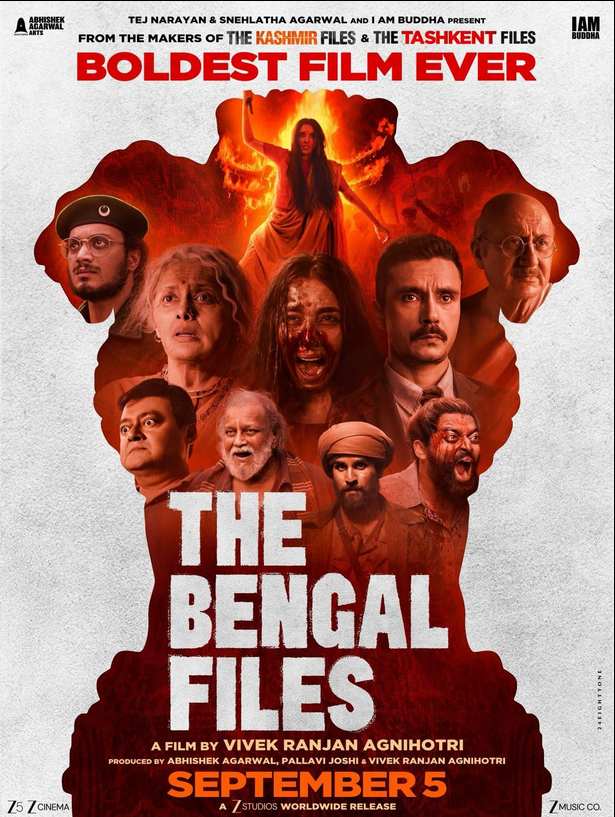There are films that entertain, there are films that inform, and then there are films like ‘The Bengal Files ‘ those films that awaken. It does not let the audience sit back comfortably; instead, it drags us into one of the darkest chapters of Indian history and forces us to confront its relevance in today’s Bengal, both in West Bengal and in Bangladesh (The Bengal Files).
The story revolves around Direct Action Day of 1946, the Noakhali riots, and the Great Calcutta Killings, those events that scarred the very soul of Bengal. Yet the film is not content with merely being a historical retelling. It draws an unflinching line between the chaos of the past and the tensions of the present. Watching it, one cannot escape the uncomfortable realization that the fault lines of the 1940s still exist, albeit in new forms.
Characters That Speak to the Soul
Mithun Chakraborty gives a career defining performance as a madman who seems detached from reality yet speaks the deepest truths of the nation. His madness is not weakness—it is the madness of suppressed voices, of generations of people who suffered silently, of Bharat itself crying out for recognition. In his character, we see both rage and compassion, both anguish and an indomitable will to endure. He is not just an individual on screen; he becomes the mirror of our collective consciousness.

Pallavi Joshi similarly takes on the character of Bharati Banerjee metaphorically as our beloved ‘Ma Bharati ‘. It is a performance laden with symbolism. She represents the motherland—violated, injured, and still caring for her son and daughter with hope and affection. At times, her eyes speak the tale of a thousand years of pain and persistence. Watching her means witnessing the embodiment of Mother India itself—shattered yet intact.
Other historical characters such as of Shurawardy, Gopal Mukherjee and Gandhiji beautifully intersect and weave the fabric of the film. It is a film directed by Vivek Agnihotriji that intertwines both the history and the present, making us think about the future.
Strength and Critique
There are moments of sharp brilliance in the film. The observation about how the police functioned then and now as puppets of the ruling dispensations is a criticism that hits uncomfortably close to home. It comes as a reminder of the risk when institutions established to guard the people yield to political forces the powers of autonomous action.
All the same, the film stutters at points. Gopal Patha’s ideology and historical gravity as one of the most central characters in those riots warranted greater elucidation and profundity. His ideology and actions were pivotal in resisting the tide of communal violence don’t just constitute a footnote in history but a whole section. By somewhat playing him down, the film misses the chance to depict the sense of self defense that Hindus in Bengal at that time represented.
Additionally, while dramatic liberties are expected in cinema, here they soften the scale of brutality of the Great Calcutta Killings. The chaos, the bloodshed, the sheer inhumanity of those days cannot be captured fully on screen, but one feels the film could have taken a bolder step in confronting the audience with the raw horror. It is known that the streets of Kolkata turned red with the dripping blood from the naked hindu women’s dead bodies. After all, history was not gentle. It was brutal, and perhaps the film could have reflected that brutality more fearlessly.
Why It Matters Today
What makes ‘The Bengal Files ‘ extraordinary is not just its historical content but its ability to hold up a mirror to the present. In today’s Bengal, where identity politics, communal divisions, and political manipulation remain as sharp as ever, this film serves as both a warning and a lesson. It tells us that if we do not learn from the mistakes of the past, we risk repeating them.
For viewers in West Bengal, it is a recapitulation of long buried wounds; for the people in Bangladesh, it evokes the unseen anguish that continues to inform their collective psyche. For the rest of India, it is a primer in how vulnerable our social fabric can be when polluted by politics and power games.
The Affective Experience
Rather than history, this film is about human life—roofs blown off and families separated, mothers who cannot locate children, and people who became each other’s enemies overnight. It’s not comfortable viewing. Sometimes it seems as if a mirror has been placed in front of you and the question asked is, ‘”If this were to recur today, would you remain quiet? Would you do something? Or turn a blind eye?”. ‘ This unease, this agitation, is what makes the film indelible.
Conclusion
‘The Bengal Files ‘ is not perfect. It takes chances, it blurs edges, it leaves half the stories untold. But it does something greater; it initiates a conversation. It makes us discuss Bengal’s wounds, forgotten truths, the harms of silence.
It is a film that Indians should watch; not just as history, but as warning and as responsibility. It recreates for us the reality that the Bengal tragedies were not individual tragedies in isolation, they were national tragedies and they shaped the fate of the subcontinent itself. If we remember them honestly, then the echoes of them may not become reality once again. ‘The Bengal Files ‘ doesn’t just inform us about what happened; it forces us to decide what precisely we will do with that memory.
BD Hindu Persecution Report: Jan-June 2025
Aritra Ghosh Dastidar